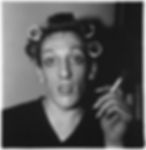Deviant and Marginalized photography by Diane Arbus
- julia_mji@me.com
- May 22, 2023
- 3 min read
Updated: Nov 30, 2023

Deviant and Marginalized photography by Diane Arbus
Diane Arbus (Born on March 14th, 1923) was an American photographer and writer with a focus on mainly deviant individuals (such as dwarfs, giants, transgender people, nudists, and circus performers). She was different from other “freak” photographers, as instead of exploiting the subjects, she would befriend them and capture them in their natural surroundings.

Her artistic talents emerged at a young age, having created interesting drawings and paintings while in high school. In 1941, she married Allan Arbus, an American actor who fostered her artistic talent by teaching her photography. Working with her husband, Diane Arbus started in advertising and fashion photography. She and Allan became quite a successful team, with photographs appearing in such magazines as Vogue. In the late 1950s, she began to focus on her photography. To further her art, Arbus studied with photographer Lisette Model around this time.

During her wanderings around New York City, Arbus began to pursue taking photographs of people she found. She visited seedy hotels, public parks, a morgue, and other various locales. These unusual images had a raw quality, and several of them found their way into the July 1960 issue of Esquire magazine. These photographs proved to be a springboard for future work. By the mid-1960s, Diane Arbus had become a well-established photographer, participating in shows at the Museum of Modern Art in New York City, among other places. She was known for going to great lengths to get the shots she wanted. She became friends with many other famous photographers, including Richard Avedon and Walker Evans.

The photograph “A Jewish Giant at Home with His Parents in The Bronx” is an excellent example of a photograph that uses compositional strategies, high-quality printing, and skilled lighting techniques. Taken in 1970, the photograph sees a supposedly nine feet tall man standing next to his tiny elderly Jewish parents. Arbus’s photographs often explore the tension between normalcy and abnormality. Here, she touches on our obsession with superhuman height – a common theme in folk tales and popular culture, from Goliath and the Golem to Andre the Giant and The Incredible Hulk. Her image and its mesmerizing subject may be seen in historical and metaphorical contexts.

When discussing Arbus’s practice in this photograph, it is hard to miss the use of lighting, printing, and the composition of the work, creating a deeper meaning. The composition of this portrait is impressive, mainly due to the difference in size between the giant and his parents. Although the difference in size, Arbus has kept all the subjects in the frame. The gelatin silver process is a common photographic process, it is one of the many ways of producing a photograph. A suspension of silver salts in gelatin is coated onto a support such as glass, flexible plastic or film, baryta paper, or resin-coated paper. Through the use of Gelatin silver print, Arbus was successfully able to show many different tones. The lighting in this photograph is also expertly used, with shadows lurking in the sides of the work, giving it an eery look, working hand in hand with the fact that giants are “abnormal” and “mysterious”.

Diane Arbus was a skilled photographer, and through her manipulation of strategies discussed, it is clear why she is such an influential photographer. What stands out about her photographs is that she connects to the subjects at a personal level, unlike other photographers who are accused of the exploitation of ”freaks”.

***All images are courtesy of the Artist
JM Art Management

